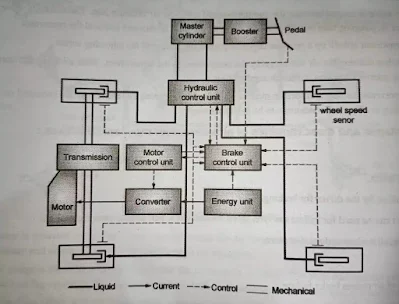Antilock Brake System ( ABS )
● ABS reduces the risk of tyres skadding under heavy braking and allows the driver to maintain steering control of the car.
ABS only operate under heavy braking or on slippery surface.
● About 40% of all car accident involve skidding.
● The most efficient breaking takes place when the wheel are the still revolving.
● If the break lock the wheel so that the tyres skid, kinetic friction result and the braking is much less effective.
● To prevent skidding and provide maximum effective breaking, Several antilog device have been developed.
● Some provide skid control rear wheel only. Other provide control at all four wheels.
● The ABS is a electronic system which used sensor like wheel speed sensor and actuator as ABS pump and Valves. This is achieved by EBD which is the sub system of ABS. Hance EBD also prevent wheels from locking under various driving condition by regulating brake pressure.
● Working principle : the ABS modulates the pressure of the brake fluid that is applied to each front and rear brake, preventing the wheel from "Locking Up” and maintaining the steering control over the vehicle. Its purpose is to prevent instability of the vehicle under extreme breaking conditions.
● The Anti-lock Braking System is located between the brake master cylinder and the wheels. The system constantly monitor each wheel through and Electronic Wheel sensor. if one of the wheel is turning slower than the other, the antilock system release the pressure on that wheel.
Working of Anti-Lock Brake System :
● ABS system have a an individual brake line for each of the four wheels, enabling different breaking pressure on different road surfaces.
● Vehicle wheel may be lock up due to excessive wheel torque over tyre road friction forces available, caused by too much hydraulic line pressure.
● The ABS monitor wheel speed and release pressure on individual wheels brake lines, rapidly pulsing individual break to prevent lock-up.
● Three channel system are equipped with a sensor for each wheel, but control the rear brake has a single unit. ABS detect the right wheel about to lock and reduced braking force on the wheel.
● The system would also reduce force on both back wheels. Both system help avoid lock up and loss of vehicle control.
● Control means that as long as the wheels are rotating,the antilog device permits normal application of the break.
● But if the break are applied so hard that the wheels tend to stop turning and a skid start to develop, the device comes into operation.
● It partly releases the break so that the wheels continue to rotate. However, breaking continues, but it it is held to just below the point where a skid would start. This result maximum breaking effect.
Pressure Modulation Valve :
The brake pressure modulate valve is control the pressure you modulation by the electric signal that is generated by the ABS module. This valve regulate the pressure that is supplied to each ABS controlled break in the wheels. The modulate valve has a set of solenoid valve, usually one for each wheel, that controlled by the ECU. In normal braking condition, The brake master cylinder provide a constant pressure to all four wheel of the vehicle. When the ABS system senses that wheel is about to lock up, it sends the appropriate signal to the pressure Modulator. In response, the valve corresponding to the faulty wheel is opened or closed to either supply more pressure to the affected will or to cut off the pressure supply to the wheel. Once all the four wheel are back to spinning at the normal Speed, the ABS switches off and all the valves on the brake pressure modulate system are made open again to supply an equal amount of breaking pressure to all four wheels.
Advantage of Anti-lock Brake System :
1. ABS reduces the risk of tyres skidding under heavy breaking.
2. Allows the driver to maintain steering control of the car.
3. Increased breaking comfort.
4. ABS only operates under heavy breaking or on slippery surfaces.
5. Improved vehicle safety.
Anti-lock Brakes Types :
● Anti Lock Braking System or ABS has different types of brake based on number of channels used.
● Four channel: In this all the four wheel have their own individual speed sensor and valves. This give better control of all the four wheels can be controlled individually which ensure the maximum braking force.
● Three channel : Three channel comes with two combination, one is three channel with four sensors and the other one which three channel and three senses.
● Two Channel : This system built with four sensor and two valves. It used the speed sensor at each wheel, with one control valve for both of the front wheel and the other one for the rear wheels.
● One Channel : It has one valve and one sensor for both of the rear wheels. This system is not very effective because as there is a possibility that one of the rear wheel will lock, reducing the effectiveness of break.


 :)
:) :(
:( =(
=( ^_^
^_^ :D
:D =D
=D =)D
=)D |o|
|o| @@,
@@, ;)
;) :-bd
:-bd :-d
:-d :p
:p :ng
:ng







